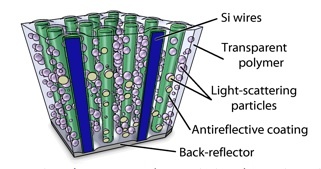Caltech claims quantum leap in solar tech

Researchers at the California Institute of Technology (Caltech) are claiming a breakthrough in solar chip design that they believe will help make solar technology more efficient--and cheaper.
I'm not a solar scientist, but the researchers apparently have achieved this by embedding silicon wire arrays throughout the design. This helps enhance the cell's ability to absorb sunlight (up to 85 percent of total collectible sunlight), while reducing the dependency on semiconductor materials. It needs about one-fiftieth of the semiconductor materials.
Here's a diagram of the design:

This is a schematic diagram of the light-trapping elements used to optimize absorption within a polymer-embedded silicon wire array.
According to Harry Atwater, professor of applied physics and materials science and director of Caltech's Resnick Institute: "We've surpassed previous optical microstructures developed to trap light. ... Many materials can absorb light quite well but not generate electricity, like, for instance black paint. What's most important in a solar cell is whether that absorption leads to the creation of charge carriers."
The researchers claim that the silicon wire arrays in the cells can convert 90 percent to 100 percent of the photons they absorb into electrons.
Not so fast, though: The cells that Caltech has created need to be scaled up before they can have commercial application. They need to be hundreds of square centimeters in size, which is about 100 times larger than the ones researchers are working with now.